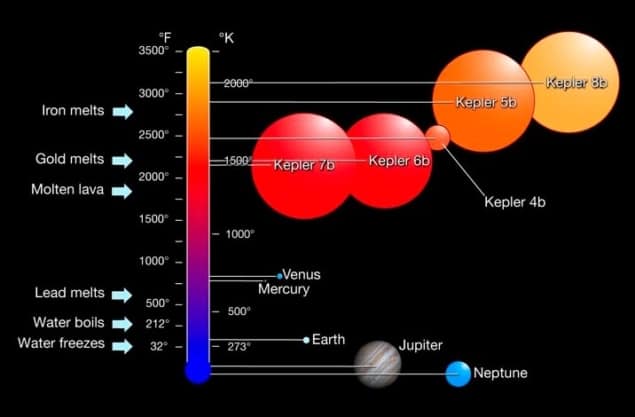
Scientists working on NASA’s Kepler mission have unveiled the first five exoplanets discovered by the space telescope since it was launched in March 2009. The exoplanets – planets orbiting stars other than the Sun – were found in Kepler’s first six weeks of operation. Although these bodies are nothing like the Earth, their rapid discovery suggests that Kepler is on track to discover a habitable exoplanet sometime in the next three years.
Kepler found the quintet by monitoring the brightness of over 156,000 stars: any orbiting exoplanet crossing the line of sight between a star and the Earth star makes the star appear dimmer. The orbital period of the planet can be determined from the period of fluctuation, while the size of the fluctuations gives the radius of the planet relative to its star.
The five planets are all much larger than the Earth, the smallest being about four times the diameter of Earth. They all have orbital periods of less than five days and are very near to their companion stars. As a result, the exoplanets are thought to have temperatures above 1500 K and are therefore not suitable for life – at least as we know it. The planets are similar to most of the 400 or so exoplanets discovered to date.
Towards longer orbits
The smallest of the new exoplanets, Kepler-4b, appears to be very similar to Neptune except that it receives much more radiation from its star. According to Kepler scientists, this implies that Kepler-4b has a higher rock-to-water ratio, or less hydrogen and helium than Neptune. Another exoplanet, Kepler-7b, has a density about 17% that of liquid water – making it the least dense exoplanet discovered to date.
“The quick discovery and confirmation of five new exoplanets shows that the Kepler mission is performing well,” says Kepler’s lead scientist William Borucki of NASA’s Ames Research Center. His team now plans to look for planets with longer orbital periods by searching through the additional eight months of data that they also have.
Finding planets with orbits of about one year is crucial for the mission to achieve its ultimate goal – the discovery of an Earth-like exoplanet in the “habitable zone” of a stellar system, where conditions are just right for life. “The emphasis in 2010 will be on the discovery of small planets,” says Borucki.
“Performing well”
Suzanne Aigrain, an astrophysicist at Oxford University in the UK, told physicsworld.com that the result “bodes very well for future discoveries based on longer datasets, which should enable the detection of smaller and longer-period planets”. She adds that both the satellite and the processes used to detect and confirm exoplanet discovery appear to be performing well.
In a bid to boost its efficiency, Kepler targets a catalogue of stars that have been pre-selected for their likelihood of harbouring detectable exoplanets. However, Aigrain observes that the preliminary results suggest that the catalogue could bias Kepler to discovering bodies orbiting larger than average stars. “This is something one will have to be careful about when attempting to extract general trends about the exoplanet population from the Kepler results,” she warns.
Kepler, which was named after the 17th century German astronomer Johannes Kepler, is expected to continue searching for exoplanets until at least November, 2012.
The results will be reported in Science.



